|
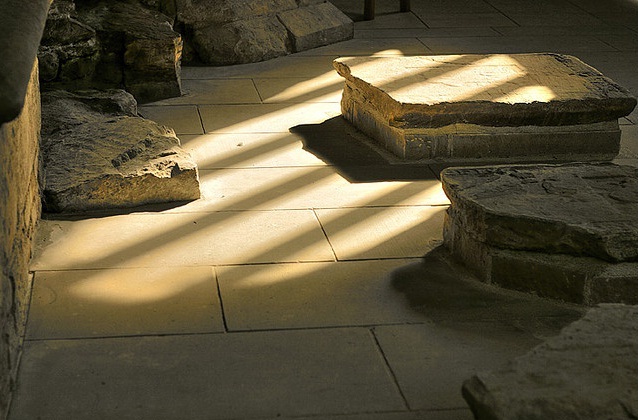 The House of Seton of Scotland has a long and complex history.
From the descendants of King Charles I of France, or
Charlemagne, they
were the seniors of the bloodline known as the
Carolingians and were local rulers governing small territories and
peoples in the Comte of Flanders, before a single family
line emerged by the
end of the eleventh century in Scotland, founded by Seier de Seton (Seier,
Scots vulgo of French
= Seigneur, the Baron of Seton). The House of Seton of Scotland has a long and complex history.
From the descendants of King Charles I of France, or
Charlemagne, they
were the seniors of the bloodline known as the
Carolingians and were local rulers governing small territories and
peoples in the Comte of Flanders, before a single family
line emerged by the
end of the eleventh century in Scotland, founded by Seier de Seton (Seier,
Scots vulgo of French
= Seigneur, the Baron of Seton).
Seier de Seton
was the eldest son of Count Lambert de Lens, of
Boulogne-sur-Mer in Flanders who died at Phalampin circa
1054 and who himself was the second son of Eustace I of the Flemish
Five Eustaces fame.
Count Lambert had married
secondly Adelaide of Normandy, daughter of Robert, Duke
of Normandy who's famed son William became Duke of
Normandy and King William I of England in 1066.
Although Lambert died in 1054, his son's were
matrimonial cousin's of King William I of England and as
such were awarded lands in the north of England for
their part in assisting his fight for the Crown.
The three crescents in the Seton arms then, in the
tinctures of Boulogne and as borne by Seier are
representative of being of Count Lambert, the second son
of Eustace I of the House of Boulogne.
Lambert de Len's daughter Judith de Lens, from his
second marriage, married Waltheof of Northumberland,
Earl of Huntingdon and Northampton, and was mother to
Maud or Matilda of Huntingdon.
Maud married: 1st
Simon de St. Liz who himself became Earl of Huntingdon
as a result but who died in 1115; and 2nd David Canmore,
son of Malcolm III of Scotland and who eventually became
the noted David I of Scotland and who died circa 1153.
This made Seier de Seton's son and heir, Walter (or
Dougall as he was commonly known and who died circa
1124), as an uncle-matrimonial to the King.
Of Flemish and of
Carolingian lineage, the manuscript at the British
Museum from the 16th century it states that "their
surnam came home with King Malcolme Camoir foorth of
Ingland".
Chalmers in his "Caledonia" states that the
first Setons were members of a Norman (Flemish)
family named "Say" (which was incorrect), and that they
obtained from David I land in East Lothian which were
called Sey-tun. Sir Richard Maitland of Lethington wrote
a "Historie or Chronicle of the Hous and Surename of
Seytoun" down to the year 1559, wrote that King Malcolm
Canmore "gaif to the predecessour and forebear of my
Lord Seytoun the surename of Seytoun... appearandlie be
ressoun that the gentilman... possessit the landis of
Seytoun for the tyme... thay landis ar callit Seytoun
for ane grit caus, becaus thay ly hard upon the Sey cost
and the Toun thairof is neir to the Sey."
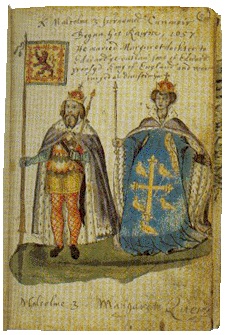 While Maitland of
Lethington had reference to the East Lothian lands of
the family as being the originator for King Malcolm's
giving of the family name, it was in fact the King's
referring to the Northumberland lands of Staithes, the
secret port or Sea-town there, for which the King made
reference to and thence we had given likewise to the
lands in East Lothian as a result. The mark of
honour however, being given the name to the family by
the King has never been forgotten and is maintained to
this day. While Maitland of
Lethington had reference to the East Lothian lands of
the family as being the originator for King Malcolm's
giving of the family name, it was in fact the King's
referring to the Northumberland lands of Staithes, the
secret port or Sea-town there, for which the King made
reference to and thence we had given likewise to the
lands in East Lothian as a result. The mark of
honour however, being given the name to the family by
the King has never been forgotten and is maintained to
this day.
In Scotland however,
in consequence of a remarkable number
of other families of the highest rank having sprung from their
main stock, the heads of the House of Seton are termed ‘Magnae Nobilitatis
Domini;’ and from their intermarriage upon four different
occasions with the Scottish Royal Family. By Royal Grant, they obtained the addition to
their shield of the royal or double tressure. Their earliest motto,
‘Hazard Yet Forward,’ is descriptive of their military ardour and
dauntless courage. They were conspicuous throughout their whole
history for their loyalty and firm attachment to the Stewart
dynasty, in whose cause they later perilled and lost their titles and
extensive estates.
In the twelfth century there was marriage with the de
Quincy's and the Seton's became heirs of that
family through the eventual female heiress. Though
politics denied them of the Earldom of Winchester, they
began to be constantly referred to as the "Earls of
Seton".
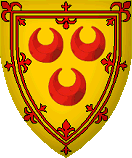 The
thirteenth century was a time of instability for the
Scottish Crown in the face of internal fighting and the
Wars of Independence with England. The Seton's,
therefore, with their military prowess and blood-ties,
were of much assistance and maintained a spotless
loyalty to their Scottish Monarchs, eventually marrying
Marjory Bruce, the sister of King Robert I and which
marriage made the Seton's lineal heirs maternal to the
Throne, seniors under the male heirs of the House of
Bruce. However, after the death of Sir Christopher
Seton, Marjory Bruce married secondly Sir Walter Stewart
and their son Robert became the 1st Stewart Monarch of
Scotland as Robert II, making Marjory's first son
Alexander Seton a half-brother maternally to King Robert
II. The
thirteenth century was a time of instability for the
Scottish Crown in the face of internal fighting and the
Wars of Independence with England. The Seton's,
therefore, with their military prowess and blood-ties,
were of much assistance and maintained a spotless
loyalty to their Scottish Monarchs, eventually marrying
Marjory Bruce, the sister of King Robert I and which
marriage made the Seton's lineal heirs maternal to the
Throne, seniors under the male heirs of the House of
Bruce. However, after the death of Sir Christopher
Seton, Marjory Bruce married secondly Sir Walter Stewart
and their son Robert became the 1st Stewart Monarch of
Scotland as Robert II, making Marjory's first son
Alexander Seton a half-brother maternally to King Robert
II.
Before
the Lords were created, the family maintained a tradition of
Knights, for thirteen generations until the mid-14th century, and
passed this training hereditarily to every son of the
House. Eventually the direct male-line of the Seton's ended
with the heiress Margaret de Seton, who married her cousin Alan de
Winton, himself a Seton descended from Philip de Seton who had
recieved the Charter of the Lands of Winton in 1169, and who's
branch of the family had taken their name of Winton from their
estate of Winton which they had recieved in patrimony, where the
Latinized name of Winton as found in both English and Scottish
documents can be found as
Wintoniensi - Wintoniensis - Wintoniae, and which in England was
called after Winchester. Their
son, Sir William Seton was knighted prior to becoming 1st Lord
Seton and was the first Scottish Lord of Parliament, which made
the Lord's Seton the Premier Baron's of Scotland.
With the accession of the Stewart
dynasty, the family reached their pinnacle evolution.
Continued loyalty to the monarchy and outstanding
historical service resulted in the first creation of a
Lord in the Scottish Parliament to be conferred on the
Setons, and Sir William Seton was created 1st Lord Seton
in the 14th century. His second son was created
Lord Gordon, who's own son was created Earl of Huntly.
As the premier Barons of Scotland, this position later
brought the Stewart heiress of the Earldom of Buchan to
the family, though they were denied title due to
politics yet again.
Lady Catherine Seton (daughter of Sir William
Seton, Master of Seton and son of Sir John Seton, 2nd Lord Seton),
married Sir Alan Stewart of Darnley (Derneley) and was mother to
Sir John Stewart of Darnley, 1st Earl of Lennox, and who's
great-great grandson, Henry Stuart, Lord Darnley married Queen
Mary I, or Mary Stuart Queen of Scots, and who was father to King
James VI by Her Majesty, and making the later Seton's cousins of
King James VI and his heirs the Stuart Kings of Great Britain, the
Hanoverian Kings of Great Britain and yet more distantly the
current House of Windsor.
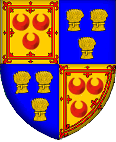 George, 3rd Lord Seton (son of Sir William Seton
and grandson of Sir John Seton, 2nd Lord Seton), married the
heiress Margaret Stewart, daughter of John Stewart, 1st Earl of
Buchan and Constable of France who was the son of Robert Stewart,
1st Duke of Albany and Regent of Scotland and who was himself the
third son of King Robert II. This lineage made the House of
Seton yet again maternal heirs to the Throne of Scotland. George, 3rd Lord Seton (son of Sir William Seton
and grandson of Sir John Seton, 2nd Lord Seton), married the
heiress Margaret Stewart, daughter of John Stewart, 1st Earl of
Buchan and Constable of France who was the son of Robert Stewart,
1st Duke of Albany and Regent of Scotland and who was himself the
third son of King Robert II. This lineage made the House of
Seton yet again maternal heirs to the Throne of Scotland.
George Seton, 6th Lord Seton, arranged the
marriage of his eldest son and heir, also George (who was to
succeed his father and become 7th Lord Seton), to Lady Isabel
Hamilton, daughter of Sir William Hamilton of Sanquhar and Sorn,
Treasurer to the King and Keeper of Edinburgh Castle. Sir
William, and thus his daughter, were close relatives and heirs
linealy of James Hamilton, 2nd Earl of Arran and Duke of
Chatellerhault in France, who was Regent of Scotland for the young
Queen Mary I, and who was the lineal heir to the Throne of
Scotland should Queen Mary not have had succession. The
marriage of George Seton with Lady Isabel Hamilton, therefore,
brought yet further ties with the Scottish Royal House and was
much celebrated by the Seton Family, having a gold medal struck to
mark the occassion.
In 1600, the head of the
House, Robert Seton, 8th Lord Seton, was created Earl of
Winton by King
James VI, before the King succeeded to the English Crown. His
brother, Alexander Seton, was Chancellor of Scotland for
King James VI and was
responsible for raising and educating the Kings son,
Charles (who later became King
Charles I), and King James created him Earl of Dunfermline in 1605.
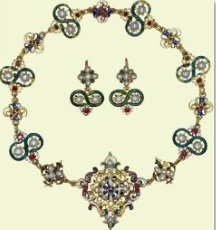 The though the family argued for, and negotiated, the Union of
the Crowns in 1603, which was followed later by the Union of the Parliaments
in 1707, they opposed the Hanoverian replacement for the
Stuart Monarchy after the death of Queen Anne in 1714.
The German-loyal troops raided and desecrated the
family's properties as incitement in light of the
family's Jacobite sympathies, which forced them into
open rebellion against the Crown and ultimately forced
the forfeiture of the family's titles and estates, which were
never restored. The though the family argued for, and negotiated, the Union of
the Crowns in 1603, which was followed later by the Union of the Parliaments
in 1707, they opposed the Hanoverian replacement for the
Stuart Monarchy after the death of Queen Anne in 1714.
The German-loyal troops raided and desecrated the
family's properties as incitement in light of the
family's Jacobite sympathies, which forced them into
open rebellion against the Crown and ultimately forced
the forfeiture of the family's titles and estates, which were
never restored.
The
Seton Necklace, won by Mary Seton from Queen Mary Stuart
in the famed game of golf played at Seton
| 

